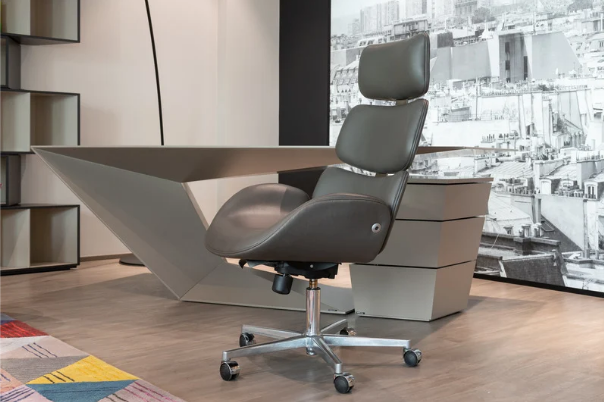In the evolving landscape of modern workspaces, the traditional office chair is undergoing a revolution. Enter the era of unconventional office chairs – innovative, ergonomic, and aesthetically unique. These chairs are breaking the mold, challenging the conventional standards of office seating.
In this article, we explore how unconventional office chairs are redefining how we think about comfort, productivity, and style in the workplace.
In the ever-evolving landscape of office environments, the idea of the conventional table chair is being challenged. With a growing emphasis on ergonomics, productiveness, and worker well-being, groups are exploring unconventional designs to redefine the standards of office seating.
These progressive chairs offer ergonomic blessings and inject creativity and persona into the workspace. Let’s delve into some of the radical workplace chairs that can reshape how we sit and work.
Exploring the Modern Office Chair Designs

The Active Sitting Stool:
Gone are the days of being desk-bound for hours. The upward push of lively sitting stools has transformed the sedentary nature of workplace office chair design into a dynamic experience. These stools generally function as rounded or saddle-fashioned seats, encouraging customers to interact with their middle muscle tissues and keep balance while seated. By promoting motion and stepped forward posture, energetic sitting stools contribute to higher spinal alignment and decreased pain over prolonged durations of sitting. Brands like Varier and ErgoErgo have pioneered this trend, supplying smooth designs that seamlessly blend these characteristics with style.
The Standing Desk Office Chairs:
As standing desk advantages expand in popularity for their fitness advantages and improved body strength benefits, the need for appropriate office chair options becomes obvious. Enter the status desk office chair, a hybrid solution that mixes the benefits of a stool with the stability of a chair.
These chairs are designed to offer support at some stage in durations of rest at the same time as allowing customers to effortlessly transition between sitting and standing positions. With adjustable heights and tilting mechanisms, they cater to individual options and sell motion at some stage in the workday. Companies like Humanscale and Steelcase provide various status desk chairs designed to supplement contemporary workspaces.
The Ergonomic Ball Chair:
Inspired by workout balls utilized in fitness exercises, ergonomic ball office chairs offer dynamic seating that promotes center power and balance. These office chairs are a inflatable ball which inspires their customers to engage their muscle tissues to hold balance. By continuously adjusting posture and weight distribution, individuals can alleviate stress at the spine and reduce the risk of discomfort associated with extended sitting. Moreover, the diffused bouncing motion stimulates the body and keeps users alert and centered. Brands like Gaiam and Vivora provide elegant variations of the conventional ball chair, making it a famous desire for fitness-aware places of work.
The Reclining Office Chair:
While traditional workplace chairs prioritize upright sitting positions, reclining chairs provide a fresh departure from the norm. These chairs allow customers to lean returned and loosen up without sacrificing balance. With adjustable recline angles and integrated lumbar aid, they sell optimal spinal alignment and decrease pressure at the lower back.
Additionally, some fashions feature footrests and swivel bases, further enhancing consolation and flexibility. Whether used for short moments of relaxation or extended intervals of targeted work, reclining office chairs offer a customizable seating experience that caters to personal preferences. Brands like Herman Miller and Steelcase have introduced modern reclining chairs that combine ergonomic layout with modern-day aesthetics.
The Rise of Ergonomic Alternatives:
Unconventional office chairs are challenging the notion that comfort in the workplace must adhere to a standard design. Ergonomics is taking center stage, with unconventional chairs offering dynamic alternatives that support natural body movements. Ball chairs, kneeling chairs, and saddle chairs are examples of ergonomic alternatives that prioritize both comfort and posture.
Active Sitting for Health and Well-being:
Traditional office chairs often encourage a sedentary lifestyle, contributing to health issues. Unconventional chairs promote active sitting, engaging core muscles and encouraging movement throughout the day. Stool chairs with swivel bases, wobble stools, or balance ball chairs engage users in subtle movements, promoting better circulation and reducing the negative effects of prolonged sitting.
Artistic Designs for Aesthetic Appeal:
Unconventional office chairs prioritize aesthetics without compromising functionality. These chairs are designed to be visually striking, incorporating artistic elements that elevate the overall look of the workspace. From sleek and minimalist designs to bold, statement-making shapes, unconventional chairs contribute to a visually appealing and inspiring office environment.
Versatile Seating Solutions:
The one-size-fits-all approach no longer applies to office seating. Unconventional chairs offer versatility, catering to a variety of work tasks and preferences. Adjustable height, modular components, and adaptable designs allow users to customize their seating experience. This versatility is particularly valuable in today’s dynamic and collaborative work settings.
Innovative Materials and Sustainable Practices:
Unconventional office chairs are embracing innovative materials and sustainable practices. From chairs made with recycled materials to those designed for easy disassembly and recycling, these chairs prioritize environmental consciousness. The use of unconventional materials adds a touch of uniqueness while contributing to the global shift towards sustainable office practices.
Technological Integration for Smart Seating:
Some unconventional chairs integrate technology to enhance the user experience. Smart chairs with built-in sensors can monitor posture, provide feedback on ergonomics, and even remind users to take breaks. These technological features contribute to a holistic approach to well-being and productivity in the workplace.
Collaborative and Flexible Seating Arrangements:
Innovative office chair designs are redefining the concept of office layouts. Collaborative seating arrangements, such as modular lounge chairs, bean bags, or hammock-inspired seating, create comfortable and relaxed spaces for teamwork and idea exchange. These flexible seating solutions contribute to a more dynamic and adaptive workplace.
Promoting Employee Engagement and Well-being:
Unconventional office chairs go beyond functionality; they contribute to a workplace culture that values employee well-being and engagement. By providing unique and comfortable seating options, organizations signal that they prioritize the physical and mental health of their workforce, ultimately fostering a positive and motivated work environment.
Unconventional office chairs are breaking free from the traditional mold, ushering in a new era of dynamic, ergonomic, and aesthetically pleasing seating solutions. From promoting active sitting and artistic designs to offering versatile seating arrangements and embracing sustainable practices, these chairs are redefining the standards of comfort and style in the workplace.
As organizations increasingly recognize the importance of a holistic approach to employee well-being, unconventional office chairs are becoming not just furniture but catalysts for a more dynamic, engaging, and innovative work culture.
Other posts you might enjoy:
3 Reasons to Replace Your Office Chair Now





